| Description | Participants | Agenda | Summary | Products | Posters |
|---|
Posters for NIMBioS Investigative Workshop
Modeling Renal Hemodynamics
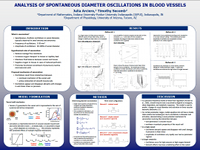 Authors:
Julia Arciero1 and Timothy Secomb2
Authors:
Julia Arciero1 and Timothy Secomb2
Institutions:
(1) Dept. of Mathematics, Indiana Univ.-Purdue Univ. Indianapolis (IUPUI), Indianapolis, IN;
(2) Dept. of Physiology, Univ. of Arizona, Tucson, AZ
Title:
Analysis of Spontaneous Diameter Oscillations in Blood Vessels.
Introduction:
Vasomotion is spontaneous, rhythmic oscillations in vessel diameter,
typically observed in small arteries and arterioles. The
frequency of oscillations is 3-30 min-1;
amplitude of oscillations is 50-100% of vessel diameter.
It is hypothesized that vasomotion
reduces average flow resistance;
increases oxygen transport to tissues or capillary bed;
maintains fluid balance between vessels and tissues;
supplies oxygen to tissues in cases of reduced perfusion; and
promotes functional recruitment of previously inactive microvascular units.
It is proposed that vasomotion
oscillations result from interactions between
nonlinear mechanics of the vessel wall
and from active contraction of smooth muscle cells.
Oscillations appear and disappear abruptly with changes
in wall shear stress or pressure.
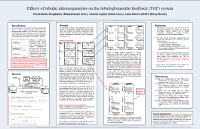 Authors:
Paula Budu-Grajdeanu1, Harold Layton2, Leon Moore3
Authors:
Paula Budu-Grajdeanu1, Harold Layton2, Leon Moore3
Institutions:
(1) Shenandoah Univ.; (2) Duke Univ.; (3) SUNY Stony Brook
Title:
Effects of tubular inhomogeneities on the tubuloglomerular feedback (TGF) system
Introduction:
An inhomogeneous model (IM) of rat thick ascending limb (TAL) is used to predict dynamic behaviors of the tubuloglomerular feedback (TGF) loop and to explain the experimental data from hypertensive rats, which have shown that TGF system may exhibit irregular oscillations with characteristics of deterministic chaos.
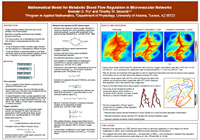 Authors:
Brendan C. Fry1 and Timothy W. Secomb1,2
Authors:
Brendan C. Fry1 and Timothy W. Secomb1,2
Institutions:
(1) Program in Applied Mathematics, Univ. of Arizona, Tucson; (2) Dept. of Physiology, Univ. of Arizona, Tucson
Title:
Mathematical Model for Metabolic Blood Flow Regulation in Microvascular Networks.
Introduction:
Oxygen exchange between blood and tissue occurs
primarily in the microcirculation.
Blood flow is regulated according to local metabolic
demands of the tissue.
The microcirculation has a heterogeneous structure with
wide variation in vessel geometry and flow rates.
Objectives are:
to use a theoretical model to simulate oxygen transport
and flow regulation in a heterogeneous network structure; and
to test the ability of a mechanism based on a red blood
cell derived signal to provide metabolic regulation of blood
flow, in response to an increase in oxygen demand.
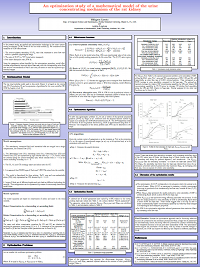 Authors:
Milagros Loreto1 and Anita Layton 2
Authors:
Milagros Loreto1 and Anita Layton 2
Institutions:
(1) Dept. of Computer Science and Mathematics, Florida Memorial Univ., Miami Gardens, FL, USA;
(2) Dept. of Mathematics, Duke Univ., Durham, NC
Title:
An Optimization Study of a Mathematical Model of the Urine Concentrating mechanism of the Rat Kidney
Abstract:
In the present study, we applied and optimization technique to the urine concentrating mechanism (UCM) model of the rat renal medulla. We considered three
measures of UCM effectiveness:
(1) The urine-to-plasma osmolality (U/P)ρ ratio that maintains a urine flow rate
within a plausible physiological range.
(2) The ratio of (U/P) to TAT (total active transport).
(3) Free water absorption rate (FWA).
Using the parameter values identified by the optimization procedure, model effectiveness is significantly improved above base-case, with the corresponding urine flow rate and the concentrations of NaCL and urea, all within or near the reported experimental ranges.
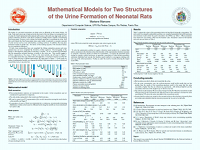 Author:
Mariano Marcano
Author:
Mariano Marcano
Institution:
Dept. of Computer Science, UPR-Rio Piedras Campus, Rio Piedras, Puerto Rico
Title:
Mathematical Models for Two Structures
of the Urine Formation of Neonatal Rats
Abstract:
The kidney of a neonatal mammalian can dilute urine as efficiently as the mature kidney. At
birth, (1) the total body water is high and at the first week of life the kidney is excreting this load
of water; (2) infants fed with maternal milk receive a diet with very high water and low
protein content. Therefore, under these conditions a healthy infant is capable of maintaining
fluid homeostasis. However, such a kidney has limited capability to concentrate the urine, and
this could disturb the fluid homeostasis when water intake is restricted or excessive amounts
of water are lost, such as occur with diarrhea, vomiting, and fever. In addition, this may place
premature infants at greater risk. The factors of this limiting capacity of the immature kidney
are not completely understood.
At birth, some mammalians have not completed the kidney maturation process and some
have not even completed the formation of their nephrons. Our knowledge of the
kidney in development, particularly its structure, is limited. Liu and co-workers postulated
that the mammalian neonatal structure is similar to the avian one. Their results suggest a
uniform organization of the loops of Henle in the renal medulla.
In a separate study, Kim and collaborators suggested a nonuniform structure and that the
loops of Henle develop in different generations. In this study, by
means of mathematical models, we compare the ability of both structures to produce dilute and
concentrated urine in neonatal rats.
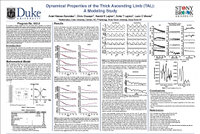 Authors:
Aniel Nieves-Gonzalez1, Chris Clausen2, Harold E Layton1, Anita T Layton1, Leon C Moore2
Authors:
Aniel Nieves-Gonzalez1, Chris Clausen2, Harold E Layton1, Anita T Layton1, Leon C Moore2
Institutions:
(1) Mathematics, Duke Univ., Durham, NC; (2) Physiology, Stony Brook Univ., Stony Brook NY
Title:
Dynamical Properties of the Thick Ascending Limb (TAL): A Modeling Study.
Abstract:
We developed a cell-based model of the TAL with tubular inflow modulated by an empirical tubuloglomerular feedback (TGF) model to study the dynamical properties of the TAL. The cellbased TAL model tracks the time evolution and space dependency of cell volume and the luminal and cytosolic concentrations of major solutes including Na+, K+, Cl and NH+ 4 . The TAL segment model consists of a stack of cell models that comprise the wall. Each cell model includes detailed representations of the major transport pathways (NKCC2, KCC4, NHE3, BCE) as well as electrodiffusion. Cell volume and pH regulation are also included in the model. We simulated the TAL with and without the TGF system using different tubular fluid inflow forcing schemes and computed transfer, covariance, and coherence functions for the TAL cells to characterize the inputoutput relationships for each solute. The results, at the segmental level, verified our earlier findings (obtained with a much simpler TAL model) that the TAL acts as a nonlinear low-pass filter with a characteristic harmonic structure. In addition, the results predict that the individual TAL cells also act as multi-input/multi-output low-pass filters. Moreover, the cells behave as delay elements with different time constants for each solute. This research was supported by NIH grants DK-89006, DK- 42091, and NSF grant DMS-0701412.
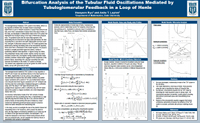 Authors:
Hwayeon Ryu and Anita T. Layton
Authors:
Hwayeon Ryu and Anita T. Layton
Institution:
Dept. of Mathematics, Duke Univ.
Title:
Bifurcation Analysis of the Tubular Fluid Oscillations Mediated by Tubuloglomerular Feedback in a Loop of Henle
Abstract:
The tubuloglomerular feedback (TGF) system in the kidney, which is a key regulator of filtration rate, has been shown in physiologic experiments in rats to mediate oscillations in tubular fluid pressure and flow, and in NaCl concentration in tubular fluid of the loop of Henle. In this study, we developed a mathematical model of the TGF system that represents NaCl transport along a short loop of Henle with compliant walls. The proximal tubule and the outer-stripe segment of the descending limb are assumed to be highly water permeable; the thick ascending limb is assumed to be water impermeable and have active NaCl transport. A bifurcation analysis of the TGF model equations was performed by deriving and finding roots of the characteristic equation, which arises from a linearization of the model equations. The analysis revealed a complex parameter region that allows a variety of qualitatively different model equations: a regime having one stable, time-independent steady-state solution; regimes having one stable oscillatory solution only; and regimes having multiple possible stable oscillatory solutions. Model results suggest that the compliance of the proximal tubule, descending limb, and thick ascending limb walls increases the tendency of the model TGF system to oscillate. This research was supported in part by NIH grants DK-42091 and DK-89066, and by NSF grant DMS-0715021.
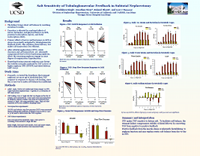 Authors:
Prabhleen Singh1, Jonathan Nizar2, Roland Blantz1, and Scott C Thomson1
Authors:
Prabhleen Singh1, Jonathan Nizar2, Roland Blantz1, and Scott C Thomson1
Institutions:
(1) Division of Nephrology-Hypertension, Univ. of California and VASDHS, San Diego;
(2) Scripps Mercy Hospital San Diego
Title:
Salt Sensitivity of Tubuloglomerular Feedback in Subtotal Nephrectomy
Background:
The kidney achieves salt balance by matching excretion to intake. Excretion is adjusted by combined effects of nerves, hormones, and physical factors on GFR, proximal reabsorption (Jprox), and distal reabsorption (Jdist). Primary effects of nerves and hormones on GFR or Jprox are normally mitigated by tubuloglomerular feedback (TGF). This feedback stabilizes distal delivery, but makes salt homeostasis less efficient. After subtotal nephrectomy (STN), solute clearance and salt homeostasis are inherently compromised due to fewer functioning nephrons, albeit the remaining nephrons engage in some degree of compensatory hyperfunction. Hyperfunctioning remnant nephrons may forego the stability normally conferred by TGF in favor of higher nephron GFR (SNGFR) and distal delivery (AJP 2009).
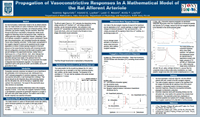 Authors: Ioannis Sgouralis 1, Harold E. Layton 1, Leon C. Moore 2, and Anita T. Layton1
Authors: Ioannis Sgouralis 1, Harold E. Layton 1, Leon C. Moore 2, and Anita T. Layton1
Institutions: (1) Dept. of Mathematics, Duke Univ.; (2) Dept. of Physiology and Biophysics, SUNY Stony Brook
Title:
Propagation of Vasoconstrictive Responses In A Mathematical Model of the Rat Afferent Arteriole.
Abstract:
We have formulated a mathematical model for the rat afferent arteriole (AA). Our model consists of a series of arteriolar smooth muscle cells, each of which represents ion transport, cell membrane potential, cellular contraction, gap junction coupling, and wall mechanics. Blood flow through the AA lumen is described by Poiseilleflow. Model results suggest that interacting calcium and potassium fluxes, mediated by voltage-gated and voltage-calcium-gated channels, respectively, give rise to periodic oscillations in cytoplasmiccalcium concentration, myosin light chain phosphorylation, and crossbridgeformation with attending muscle stress mediating vasomotion. The AA model's representation of the myogenicresponse is based on the hypothesis that the voltage dependence of calcium channel openings responds to transmuralpressure so that vessel diameter decreases with increasing pressure. With this configuration, the results of the AA model simulations agree well with findings in the experimental literature, notably those of Steinhausenet al. (J Physiol505:493, 1997), which indicated that propagated vasoconstrictiveresponse induced by local electrical stimulation decayed more rapidly in the upstream than in the downstream flow direction. The model can be incorporated into models of integrated renal hemodynamic regulation. This research was supported in part by NIH grants DK-42091 and DK-89066, and by NSF grant DMS-0715021.
NIMBioS
1122 Volunteer Blvd., Suite 106
University of Tennessee
Knoxville,
TN 37996-3410
PH: (865) 974-9334
FAX: (865) 974-9461
Contact NIMBioS


